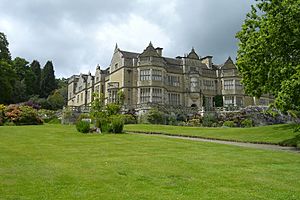Stokesay Court facts for kids
Quick facts for kids Stokesay Court |
|
|---|---|

"The most grandiloquent Victorian mansion in the county"
|
|
| Location | Onibury, Shropshire, England |
| Built | 1889–1895 |
| Built for | John Derby Allcroft |
| Original use | Country house |
| Architect | Thomas Harris |
| Architectural style(s) | Jacobethan |
| Governing body | Privately owned |
|
Listed Building – Grade II*
|
|
| Official name: Stokesay Court | |
| Designated | 28 January 1974 |
| Reference no. | 1269851 |
|
Listed Building – Grade II
|
|
| Official name: Stables, outbuildings and house at Stokesay Court | |
| Designated | 15 March 1974 |
| Reference no. | 1269855 |
|
Listed Building – Grade II
|
|
| Official name: Bridge on drive at Stokesay Court | |
| Designated | 21 June 1996 |
| Reference no. | 1269852 |
|
Listed Building – Grade II
|
|
| Official name: Lodge and attached wall at Stokesay Court | |
| Designated | 15 March 1974 |
| Reference no. | 1269854 |
|
Listed Building – Grade II
|
|
| Official name: Entrance gates, piers, wing walls and screens at Stokesay Court | |
| Designated | 15 March 1974 |
| Reference no. | 1269853 |
| Lua error in Module:Location_map at line 420: attempt to index field 'wikibase' (a nil value). | |
Stokesay Court is a large, beautiful house and its surrounding land in Shropshire, England. It is located near the village of Onibury. People often describe it as "the most amazing Victorian mansion in the county." Stokesay Court is a very important historical building, listed as a Grade II* building. This means it's considered a special building that needs to be protected.
Contents
Building Stokesay Court
Who Built This Grand House?
Stokesay Court was built for a wealthy man named John Derby Allcroft. He hired an architect named Thomas Harris to design his dream home. John Derby Allcroft became very rich from his family's glove-making business. His company, Dent, Allcroft & Co., grew to be the biggest glove manufacturer in the world!
John was also a very kind person who helped others. He built churches and was even a member of parliament, helping to make laws for the country. He bought the land for Stokesay Court in 1868. He already owned Stokesay Castle nearby, but he felt it wasn't suitable for his family. The small house on the land wasn't big enough either. So, in 1874, he bought more land to build his grand new mansion.
A Modern Marvel for Its Time
Building the house took from 1889 to 1892. Sadly, John Derby Allcroft passed away just six months after it was finished. Stokesay Court was one of the first houses in England to have electric lights built right into it! This was a very new and exciting technology in 1891. The beautiful gardens around the house were designed by Henry Ernest Milner.
The House Through the Years
After John's death, the house was passed down through his family. During the First World War, Stokesay Court was used as a hospital for soldiers who were recovering. In the Second World War, it became a temporary home for students from Lancing College and a training school for young military leaders.
In 1994, many of the house's original items were sold at a big auction. This sale helped to pay for important repairs to the building. Today, Stokesay Court is owned by Caroline Magnus, a descendant of the original family.
Stokesay Court on the Big Screen
You might have even seen Stokesay Court before and not known it! The house was the main filming location for the 2007 movie Atonement.
The Design of Stokesay Court
Stokesay Court sits on a hill and offers amazing views of Ludlow and the Clee Hills. As mentioned before, it's known as "the most amazing Victorian mansion in the county." Its special design and history are why it's protected as a Grade II* listed building.
See also
- Grade II* listed buildings in Shropshire Council (H–Z)
- Listed buildings in Onibury

